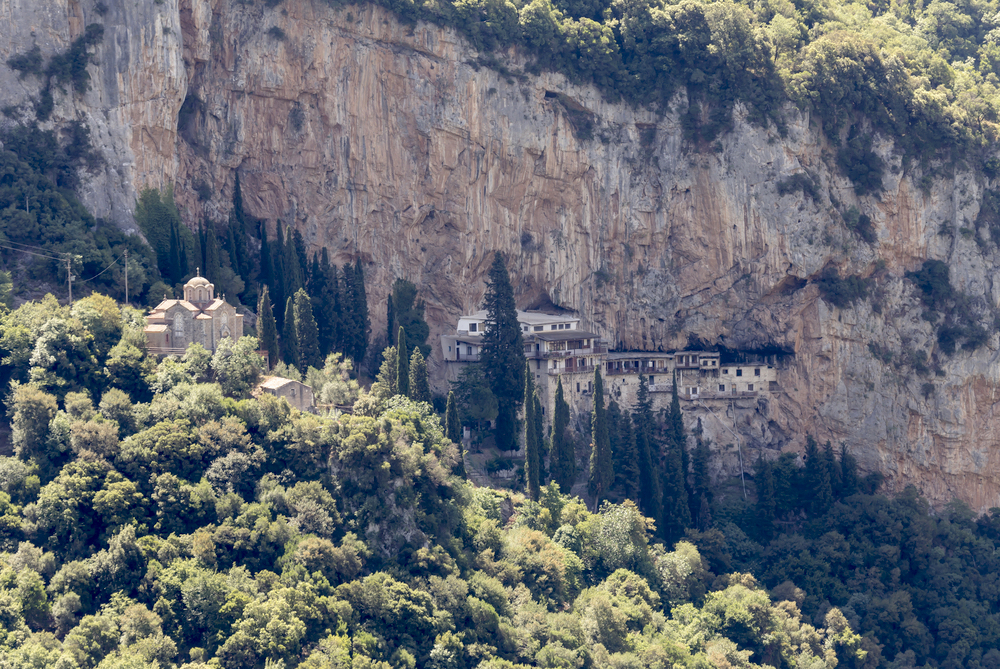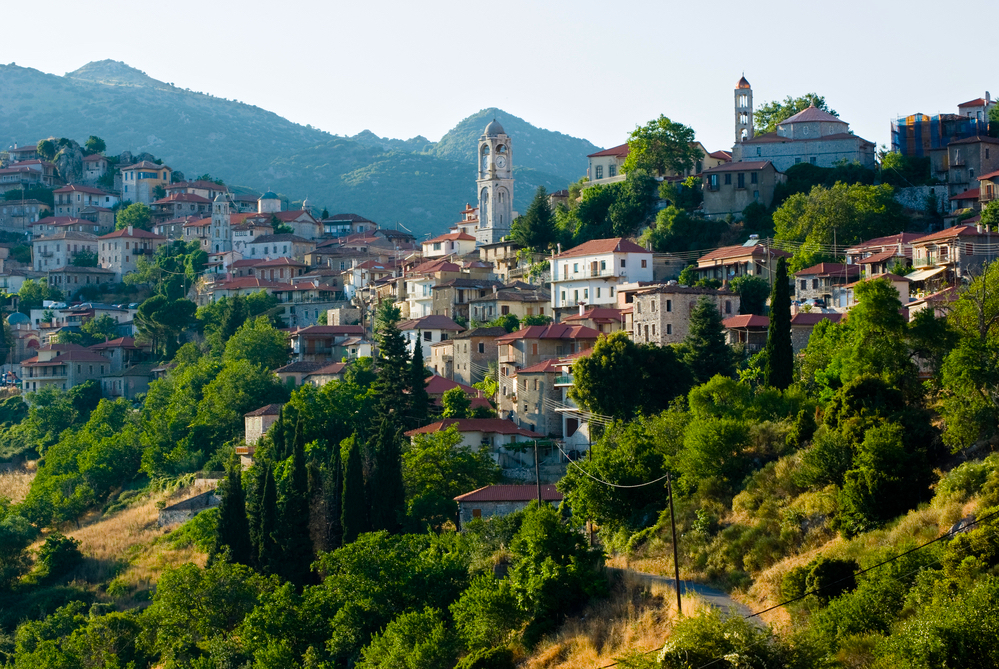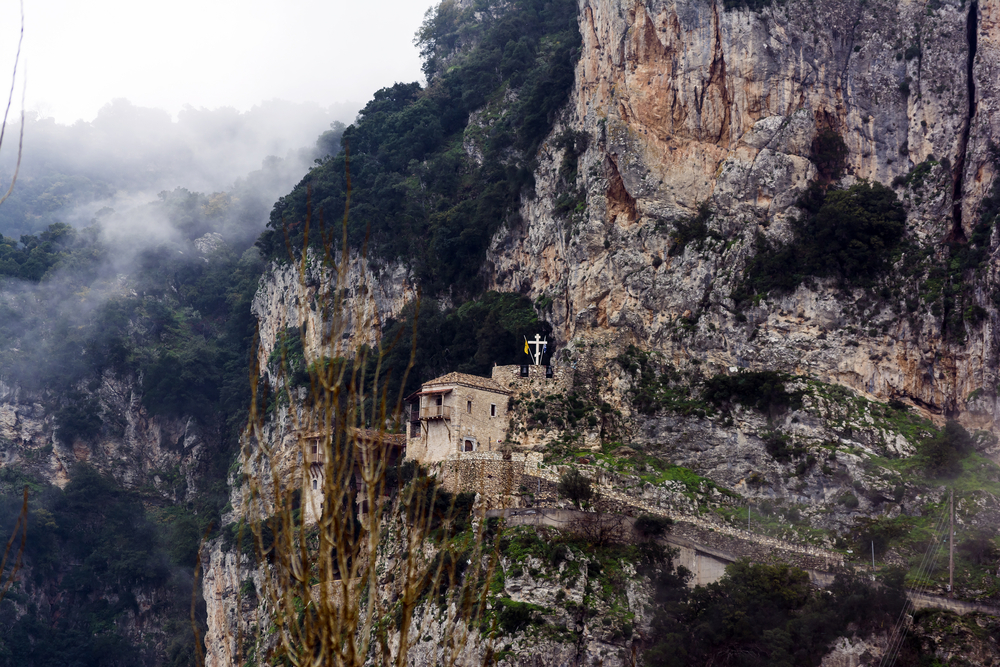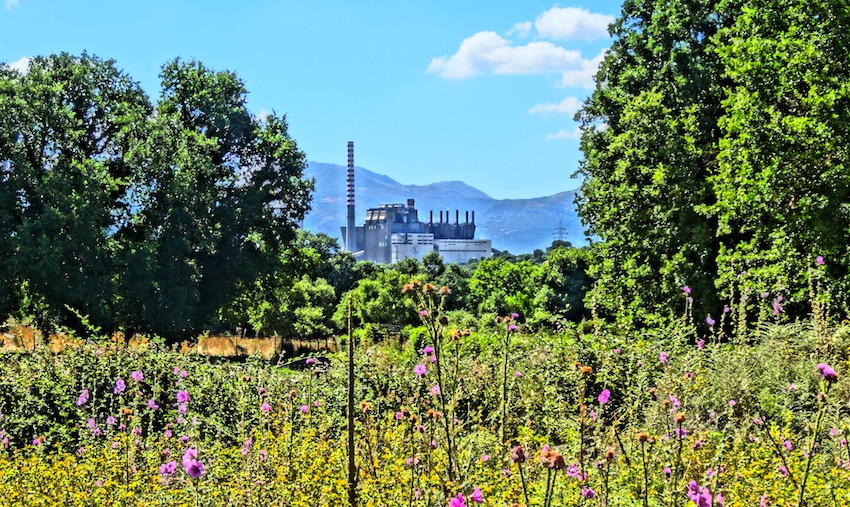
Hiking in Greece
Shady Footpath in the Peloponnesus
—even in July!

|
A lovely hike for walkers of all levels is the well-maintained and well-marked footpath to the Monastery of St. John the Baptist, clinging to the sheer cliffs on the eastern side of the Loussios River Gorge in the mountains of Arcadia |
|
By Janet McGiffin During the hot dry summers of the Peloponnesus, a lovely hike for walkers of all levels is the well-maintained and well-marked footpath to the Monastery of St. John the Baptist, Ioannis o Prodromos, founded by Manuel Comnenos in 1167. The monastery clings to the sheer cliffs on the eastern side of the Loussios River Gorge in the mountains of Arcadia where the god Pan is first thought to have appeared to the ancients. Far below the monastery by the cold waters of the Loussios River is the archeological site of the Asklipeion of Ancient Gortys, 4th Century B.C.E. Walkers seeking an easy stroll will enjoy the first part to the Old Prodromos Bridge and those wanting to stretch their legs can climb the switchbacks through the trees to the monastery. In summer heat, figure half an hour to the bridge and another half hour to the monastery. |
|
|
|
Spend a night in Dimitsana, Karkadou, or Lagadia. (See Booking.com's Peloponessos Page for lodgings.) In the morning, first visit the restored Dimitsana Open-air Water Power Museum below the Hotel Dimitsana, about 500 meters south of Dimitsana. The road down to the Monastery of St. John the Baptist is nearby. Or ask at the lovely Hotel Dimitsana. Steady nerves! The narrow road to the monastery drops steeply with sharp U-turns, long views, and narrow switch-backs! Part way down are Ministry of Archeology signs to the Monastery of St. John the Baptist and the School of Greek Letters, a private institution. You can park near the monastery, but it’s nicer to continue to the gorge floor and follow the trail along the river and shady forest. Park at the bottom and cross the bridge, following the signs to the archeological site of Ancient Gortys. Shady picnic areas are on both sides of the river. The route to the trails to the monastery is to your right, but the deserted Asklipeion, the therapeutic center of Ancient Gortys, is to the left—worth a poke around. A circular portico with round backed seats is believed to have been part of this healing center. Remains of houses have also been found. In July, tall dry vegetation dotted with thistles obscure the ancient stones, but a closer look at the weeds shows that in spring it’s a riot of flowers. Some consider it one of Greece’s lovelier archeological sites. Now turn up the road toward the trail head. A deserted mill is on your right with a shady picnic site at river level. Even in July, the water here is deep and swift. Continue past the Byzantine Church of St. Andreas which incorporates ancient stones and find the trail head—easy to spot because of the large poster map. |
|
|
|
The first half hour walk is a pleasant stroll above the Loussios River to the Old Prodromos Bridge. It’s ideal for relaxed walkers who like to photograph spectacular cliffs and linger under shady plane trees, fig trees, and wild pear trees. Kermes Oak line the trail, distinguished by holly-barbed leaves and tiny acorns. The Kermes Oak grows prolifically around the Mediterranean and is the home of the dye-insect, the Mediterranean Kermes, which lives as a parasite on the tree. The female insects with their unborn larvae are pea-sized reddish balls on the Oak. These are easily collected, killed in vinegar, and dried into dye powder. When combined with an alum in a dye bath, the dye turns wool red tinged with light yellow. Silk becomes scarlet or red-pink. According to one dye authority, "The origins probably go back to the Sumerians in the 3rd millennium B.C. Since 1464, the famous purple of the robes of Roman Catholic cardinals is no longer the Tyrian purple of the purple snail but rather an intense Kermes red, a change that occurred with the demise of purple dyeing in Constantinople after the Ottoman conquest of the Byzantine Empire in 1453 which led the pope to order the establishment of Kermes dyeing." In deeper shade along the footpath are flowers still in bloom in July, including the Rock Rose, another dye-plant that yields intense yellow or yellow-orange. The trail climbs gradually but the river drops steeply, so by the time you reach the Old Prodromos Bridge where the monks used to come for water, there are spectacular views to white river far below. Those wanting to stop here can spend a shady picnic hour dangling their feet in very cold stream water that runs through the ruins of an ancient rock-hewn building. |
|
|
|
The Chapel inside the Monastery of St John the Baptist After the Old Prodromos Bridge, it’s all switchbacks through forest up to the monastery which suddenly appears overhead, attached like mud-wasp nests to sheer rock, the many stories and tiny windows of the hermitages mysteriously medieval. The monastery church is open for visitors. At the top of the trail, look to the right and open the gate into the churchyard. Benches line a low stone wall overlooking the gorge and surround a tall plane tree. Cold water from a spigot set into the rock tastes marvelous. If you have bare legs, male or female, select a long skirt from an odd assortment hanging on hooks and continue up the steps into the church. The door is constructed of iron plates corroded around the edges and secured by broad iron nails indiscriminately hammered into heavy weathered wood. It is likely that no one will be around to guide you where to go or not to go, but forge ahead through the long narrow and bare entrance room with its deep-set windows, then climb the curving stone steps. You emerge into a tall vaulted hallway formed by a vast rock wall on one side and several rooms opening on the other. The chapel is open to visitors, but nothing else. Happily, the doors to the sitting room and kitchen were wide open, so I peeked into charming spacious rooms with wood floors covered with heavy red woven rugs and furnished with wooden couches and chairs cushioned by red embroidered pillows. A old woman wearing all black was standing by the chapel door holding a round loaf of bread for a monk to bless. She motioned me into the chapel. The chapel door is at the top of a few more steep steps. Grope your way inside and wait for your eyes to accustom to the impenetrable blackness. My eyes never did adapt. All I could make out was the faint glimmer of one votive candle somewhere ahead flickering on an iconostasis. Barking my shins helped me determine that it is a small narrow room with a row of monk’s chairs fastened to one wall and small chairs positioned to be easy to trip over—a chapel to be experienced rather than seen. After a brief recovery in the shaded churchyard, descend again. A path to the left leads under the hermitages, the path straight down returns to the Old Prodromos Bridge. |
|
|
|
Avoid Megalopolis A coal-powered electric power plant and a lignite mine make Megalopolis a town to avoid. Although the sign from the parking lot points that direction, the most beautiful route to Tripoli or to Nafplion a few hours away is through Stemnitsa. Return up the hair-pin curves. At the main road, turned right (south) towards Stemnitsa or left (north) toward Vytina and a cool lunch under a plane tree. Janet McGiffin lives in Athens partly because it is so easy to travel to anywhere from Greece. She is a writer of mystery novels and travel articles. She also writes grant proposals for non-profit organizations (NGO) based around the Mediterranean. Currently she is public-education publicist for a 24-partner European Union cultural project involving conservation of ancient monuments. You can e-mail her at mcgiffin@otenet.gr For more on the Peloponessos see Matt's Guide to the Peloponnesos |
Help Support Matt's Greece Guides
Do you enjoy using my site? Have you found it entertaining as well as useful? If so please show your appreciation by booking hotels through the travel agencies and the links found on my Hotels of Greece site. The small commission I make on the bookings enable me to keep working and in most cases you won't find them any cheaper by searching elsewhere.
You can find
hotels in Greece by location, price, whether or not it has a swimming pool, and see photos and reviews by using this link to booking.com which also contributes to my website when you book. If you are appreciative of all the free information you get on my websites you can also send
a donation through Paypal or Venmo
Join Matt Barrett's Greece Travel Guides Group on Facebook for comments, photos and other fun stuff. If you enjoy this website please share it with your friends on Facebook and other social media.








